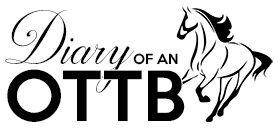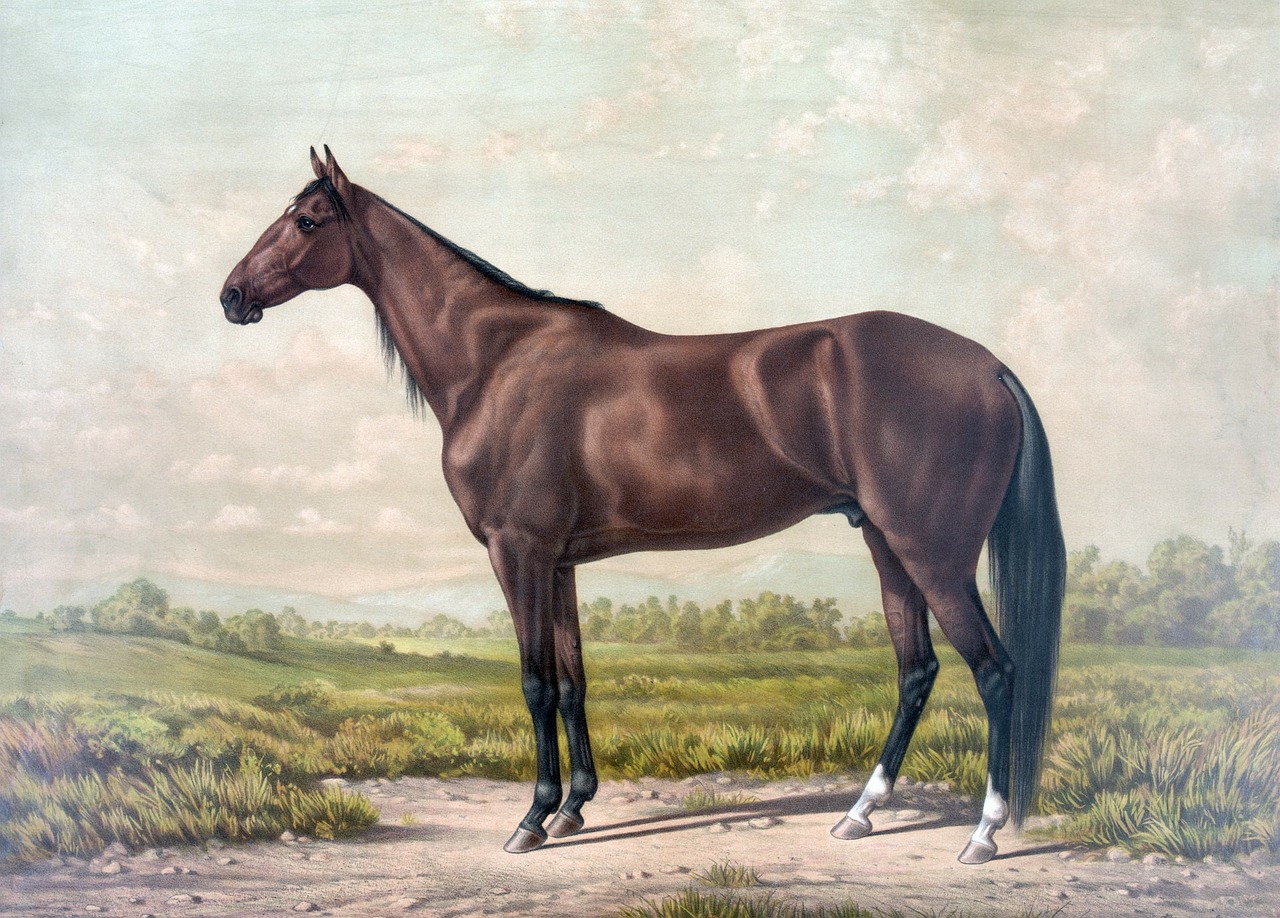By nature all horses are crooked and asymmetrical. You probably understand this if you’ve ever ridden a horse who’s not quite sure what you’re asking them to do…. and you probably already know what that feels like — something kind of like putting a toddler behind a steering wheel — abrupt shifts in weight and trajectory with no rhyme or reason or identifiable pattern.
This is why achieving consistent straightness is one of the most fundamental principals of dressage. Whether we realize it or not we’re constantly helping or hindering this process in particular when it comes to trying to teach this concept to off track Thoroughbreds or when you’re working with stiff, older, or particularly asymmetrically built horses.
Which kind of got me thinking… we constantly concern ourselves with circles and training our horses to stay along a rail, but rarely do we truly focus on how “straightly” a horse moves. We just assume that they are and go on where we’d like to go. So why concern ourselves with it and why is it important for an off track Thoroughbred or really any horse, especially older horses or stiff ones?
Why We Care About How “Straight” Our Horses Are
All horses are crooked to varying degrees and have a preference in terms of which direction they travel in, just as humans have a preference for which hand they write with.
To wrap our heads around this concept let’s first break down what we mean by a horse moving straightly.
The FEI defines straightness as:
“The horse is straight when its forehand is in line with its hindquarters, that is, when the longitudinal axis is in line with the straight or curved track it is following.”
All of a sudden the word straight feels a lot more complicated, am I right?
Dressage Today has a more straightforeward definition, all puns intended, of straightness as “a horse is straight when his body is properly aligned from poll to tail… he should be straight along the length of his body.” A better way of understanding straightness is to think of it as proper alignment in a horse.
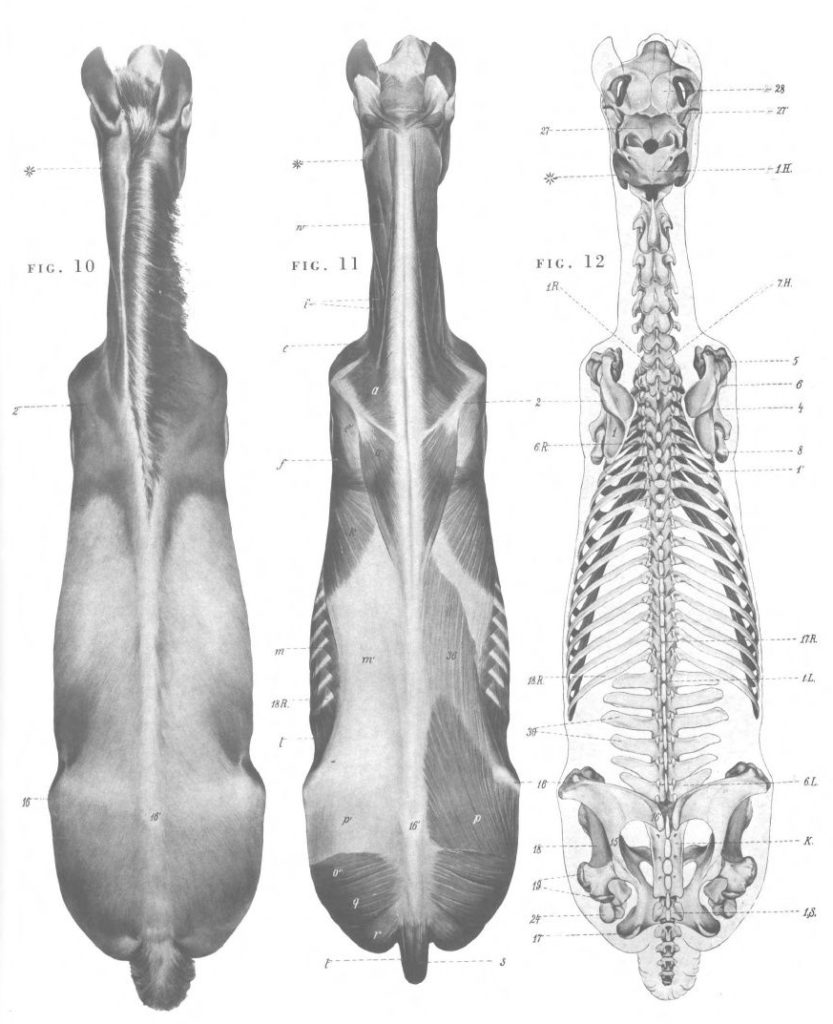
Each of these horses are standing almost perfectly straight because, well, I assume this is from a textbook so horses are perfect! In reality you might see horses who move more similar to this, as illustrated from the book Straightening the Crooked Horse.
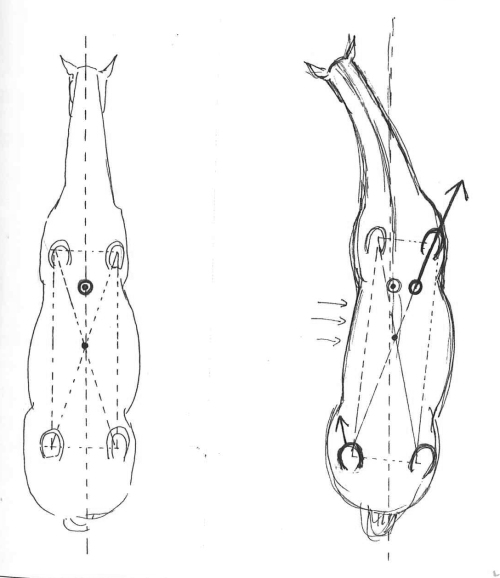
The horse shown above has a preference of traveling to the right. This preference can create an unevenness, especially with green horses like untrained off track Thoroughbreds, but it can just as easily happen with equally awesome horses who are conformationally uneven, may be older, or suffering from arthritis and may be stiff as a result. The reasons don’t really matter so much as the reality — many of us start out with a crooked horse whether we realize it or not.
Which brings us to the “why.” Why do we care if our horse is crooked or can move in a straight line?
A straight horse will almost always be more coordinated, better balanced, and give you better quality work. Not to mention, increase your dressage scores. Developing straightness is also a prerequisite and second only to collection at the top of the dressage training pyramid. At it’s core, moving with straightness translates to even weight distribution and even stress on muscles, tendons, joints, and ligaments. This helps any horse maintain their health and soundness for ridden work over the years.
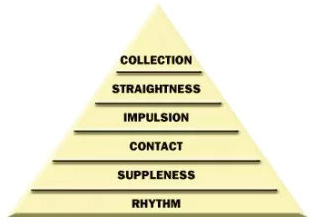
But why is it considered that difficult when a beginner can hop on a horse and walk in a somewhat straight line?
The simple answer is that straightness, at least as we define it in the horse world, isn’t so much a matter of direction as it is a way that the horse carries him or herself in proper alignment. That’s what we work towards developing over time and practice and aim to teach through straightness training on the ground and each time we ride.
Exercises & Patterns to Develop Straightness
You’ve probably gotten yourself worked up at this point worried that your horse is as crooked as a politician. They aren’t. They’re horses and they’re perfectly happy being their asymmetrical selves. To the untrained eye, you might never notice their asymmetrical nature. You might also be thinking that you’ve got to ride in a whole lot of straight lines to develop straightness… You’d be wrong on that one.
To develop straightness it’s best to start on the ground with lots of circles and bending exercises that will eventually carry those fundamentals into your riding as well. All of this training is designed to make your horse more ambidextrous than he or she might currently be at all three gaits.
Keep in mind, the slower the gait, the more challenging it is to remain straight and balanced. Think of riding a bicycle — the slower you’re moving forward, the more difficult it is to ride in a perfectly straight line. Speeding up and pedaling faster instantly solves this problem and the same is true with your horse. Increasing impulsion can often solve some straightness problems.
Before getting into the exercises I want to mention a few words of caution about pattern work. Patterns and the work they encourage are only as good as how frequently they’re repeated correctly. Consistent. Accuracy.
NOT ALL PRACTICE MAKES PERFECT. ONLY PERFECT PRACTICE MAKES PERFECT.
– Vince Lombardi
Getting that perfect practice is the key to any work with horses. It’s just as much of a key to reward that practice as soon as it’s perfect with the appropriate release. That’s how you develop good habits like soft hands and continue to encourage your mount to make good decisions. Seek perfection, reward with release, and then ask again for a little more perfect, rewarding as soon as the correct option is chosen.
It’s this awareness on the part of the rider that allows the horse to search for the correct answer and physically sort themselves out. And in reality, that’s what most horses need to do in order to get straight. This also isn’t something that can’t happen at a walk or even at a slow trot for just a few minutes. It comes after lengthy work sessions, particularly with those horses who might be a little less cooperative, with consistent sessions of 25-30 minutes of rhythmic trotting on a pattern with the horse being rewarded each time they make the right choice.
That’s where the breakthroughs happen.
Figure Eight Patterns
One of the best exercises to start developing balance, a key element in the straightness game, is to start with figure 8 patterns. This can be done either on the ground or under saddle. Remember, the slower the gait, the more difficult it will be to remain straight.
Pat Parelli teaches some great techniques for how to do this from a lunge line with your horse. Really what you’re working on developing here is getting your horse to listen and shift their weight with proper alignment and propulsion with relation to the pattern. Proper alignment and propulsion here will be bending, shoulder-in, in the correct direction of each turn and then repeating on the opposite side in the opposite direction. This is a great exercise for building balance, increasing flexibility, and starting to teach your horse to search for straightness while bending through turns.
The same concepts can also be applied in a figure 8 pattern in the saddle, as demonstrated in the video above. If you really wanted to step up this practice you could easily add a few poles to the pattern on the ground , continuing to work at a trot which encouraging the horse to engage their hind end and listen to your aids through the circles.
Serpentine
When it comes to developing straightness and consistency, patterns, transitions, and changes of directions are going to be your absolute best friend. A step up from the basic figure 8 pattern, the serpentine incorporates all of these elements and allows you to focus on controlling speed while bending, shoulder-in, consistently in the correct direction in response to your aids.
It’s essential for horses to develop a good sense of balance in order for them to move consistently forward in a straight frame. Using a pattern that emphasizes changes of direction help the horse sort this out for themselves and the serpentine pattern as demonstrated above is an excellent tool for teaching this.
Four Leaf Clovers & Cavalettis
Just as the serpentine pattern constantly encourages bending, the four leaf clover does the same thing in principal but begins to incorporate sections of straightaways where your horse will have the opportunity to lengthen him or herself out in a straight line.
This exercise and pattern at a trot is one of the most commonly used to work on issues like speed control, high-headedness, and to improve balance. It can also be made more difficult using a box formation of poles, or by placing poles around the circles of each leaf of the clover. You can check out some awesome polework examples in the videos above and below.
This is an excellent example of how the progression of poles can be worked into a more difficult pattern, encouraging the horse to move straight down the center of the downed poles.
Maintaining Straightness
This Dressage TV episode directly answers the age old question, “How do we keep our horse straight?” with the help of Australian dressage rider, Natasha Althoff.
Her answer for maintaining straightness relies on the riders aids and their ability to recognize when the horse’s hind end falls in. To compensate she recommends riding “shoulder-in.”
No matter what kind of work you’re doing, I hope this was useful and informative to help keep you and your horse on the straight and narrow!
Did I miss your favorite exercise or pattern that you use to help develop straightness in your horse? Let me know in the comments below!
